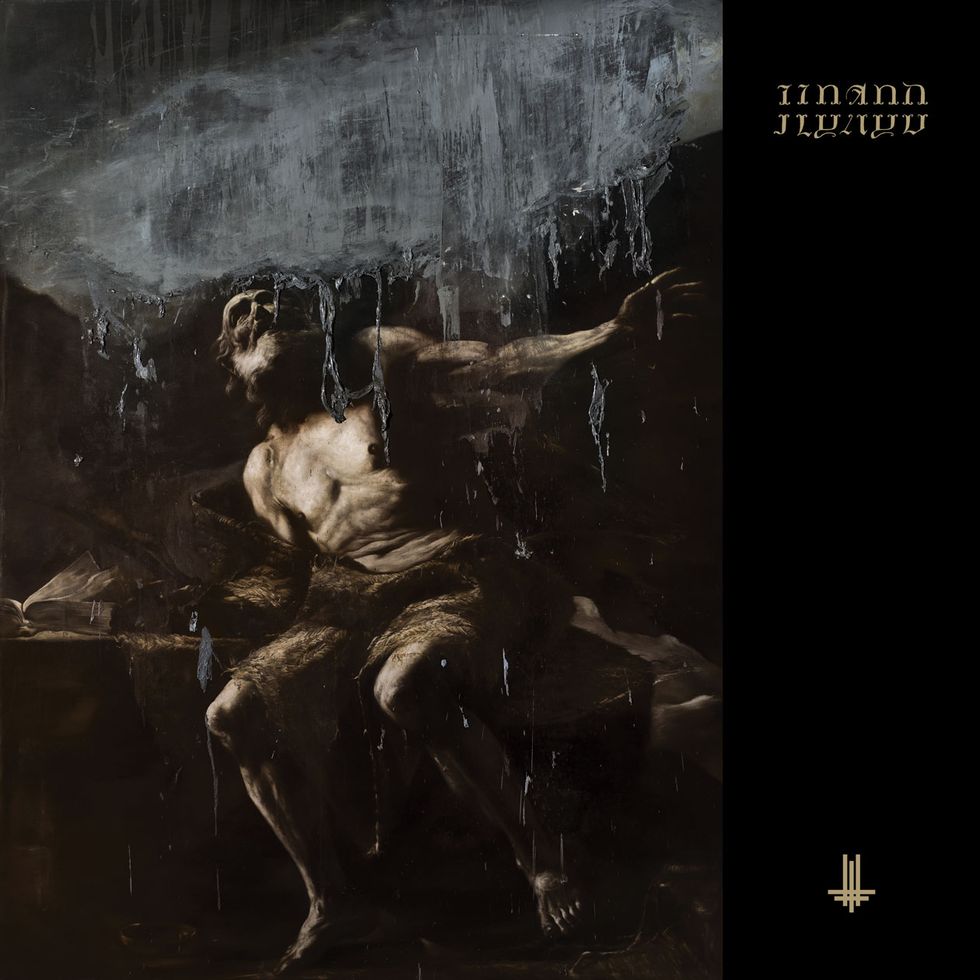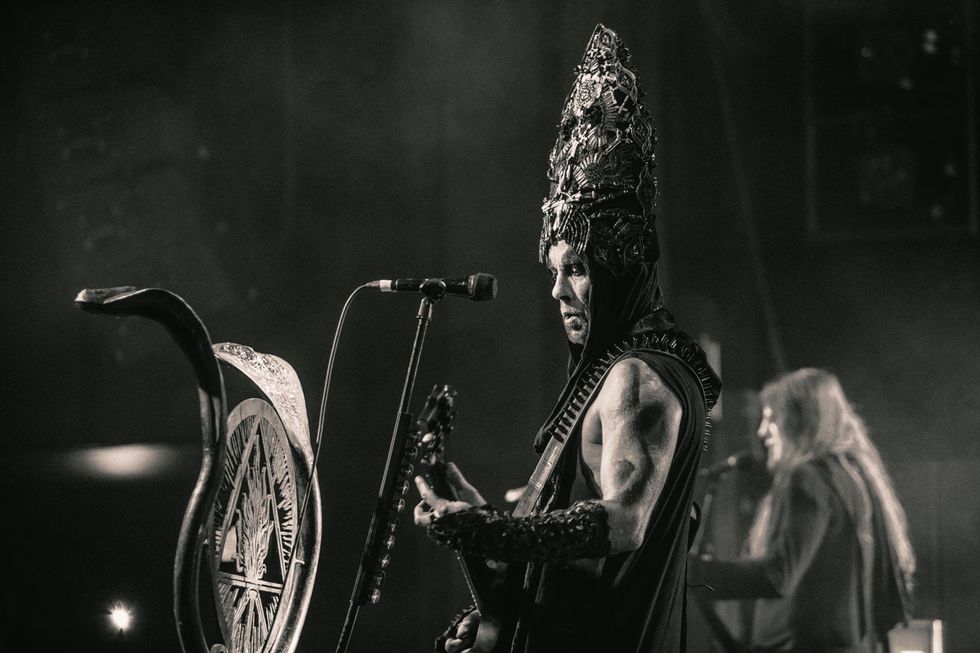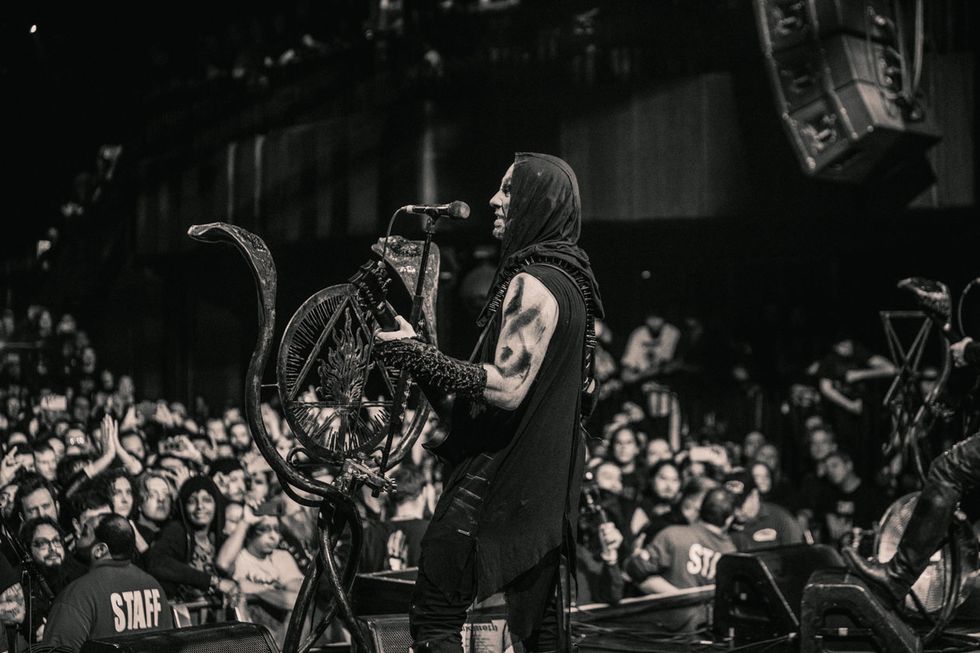Since their debut nearly 30 years ago, Polish metal outfit Behemoth has always been unapologetically intense—musically, lyrically, and aesthetically. But with 10 studio albums now in the band’s wake, their sound has developed from a potent take on black metal’s fury into a multifaceted beast that flexes with dynamic sensibility and nuance rarely seen in extreme metal. With their 11th studio LP, the monumental I Loved You at Your Darkest, vocalist/guitarist/bandleader Adam “Nergal” Darski, bassist Thomasz “Orion” Wróblewski, and drummer Zbigniew “Inferno” Promiński (along with hired-gun lead guitarist Patryk “Seth” Sztyber) have submitted a mission statement that puts artistry at the forefront and defies the notion that great metal thrives exclusively on bludgeoning guitars and maxed faders.
A far cry from the lo-fi sonic blizzards of early Behemoth releases, I Loved You at Your Darkest is a punishing yet surprisingly diverse stomp down paths not unlike those the band took on 2014’s The Satanist. Nergal and company still brandish many of the musical weapons honed during their time as a traditional black-metal band—including searing, tremolo-picked minor chords, pummeling blast beats, and jarring tempo shifts. But these calling cards now fall in the context of arrangements that fuse black metal’s ethos and speed with death metal’s brute force and rock ’n’ roll-inspired tones and structural ideas, culminating in a sound that’s utterly Behemoth.
In fact, if the critical reception the new album has enjoyed is any indication, Behemoth is advancing extreme metal beyond the stereotypes of its various subgenres and proving that heavy music can be a form of high art when freed from the shackles of “authenticity” that establishment figures often force upon even vanguard artists.
Despite the band’s obvious love for impactful imagery—in everything from their stage makeup and attire to the feature-film-like cinematography and costuming of their videos—band visionary Nergal says he’s not interested in prog-rock or traditional narrative-style concept albums. Even so, I Loved You at Your Darkest does have a loose conceptual theme that traces the band’s trajectory over the years through 12 tracks, most of which feature the sorts of brazenly blasphemous but intellectually approached lyrical themes that have come to typify Behemoth releases.
For many casual listeners, the band’s visual drama and Nergal’s penchant for blatant profanity (which is informed by both several years of history studies at the University of Gdańsk, and his upbringing in a country where Catholicism is a dominant societal force) can be a distraction from the members’ immense prowess as instrumentalists. However, I Loved You at Your Darkest allows Behemoth’s musicianship—and Nergal’s growth as a songwriter and arranger—to shine. Underpinned by a maturity and restraint that gives the album breathing room unheard in past efforts, and accentuated by an organic production style that shirks the sterility that plagues many extreme-metal records, I Loved You at Your Darkest sees Nergal settling into the role of reformed shredder. Void of superfluous guitar solos or particularly technical flights of fancy, the mood is instead set by heaps of texture, unconventional layering ideas, and solos that truly serve the song. There’s even some acoustic guitar. That’s not to say there isn’t plenty of the churning rhythm work, atonal riffing, and angular leads that Behemoth fans have come to expect. But those elements are used more thoughtfully for greater impact.
When PG spoke with Nergal—who also fronts the dark blues ’n’ roots outfit Me and That Man—he was in the midst of a whirlwind press tour in his native Poland. While well known for his intimidating stage presence and a voice that could only belong to a man in league with Satan, we found Nergal a deep-thinking and articulate interviewee. Our discussion ranged from the new album’s writing and recording processes to lessons learned from Slayer’s Kerry King and Gary Holt, stealing from Jack White, and taking a holistic approach to art.
Behemoth’s last studio album moved away from traditional black-metal structures and started exploring more rock ’n’ roll-like elements, and I Loved You at Your Darkest takes that even further—especially with some of the alt- and classic-rock vibes in the guitars. Where were you coming from this time around?
What you hear on this record is really a summary of who we are as musicians, and who we are as artists and people. I process a lot of inspiring things from disparate places and spit them back out, and that’s what you hear in these songs. As far as my guitar playing goes, I’m definitely opening up a bit. On earlier records, I was very stiffly attached to certain sonic patterns and ideas that come from the metal world, but on The Satanist—and especially I Loved You at Your Darkest—I’ve really liberated myself and decided to go with the flow. I didn’t restrain myself or limit the exploration of an idea just because it doesn’t necessarily belong within extreme-metal or black-metal standards. We’re just much more open to freely exploring all of the influences that exist within us and that have always been there. We don’t want to end up like a hamster, chasing ourselves around on a wheel by doing the same shit over and over again, and I think you can still be an extreme-metal band and pull from other genres. So the idea is to blend elements from other musical worlds in with what we do to give our own music a wider range of colors.

TIDBIT: Nergal’s main guitars for tracking the band’s 11th LP were his signature ESP single-cuts, but Fenders—primarily a Telecaster—Gibsons, and Jacksons also factored into creating guitar sounds with a bit more classic-rock crispness.
And yet it’s still a very cohesive album—and as heavy, in its own way, as anything the band’s put out.
A lot of bands in our world play it safe and don’t want to risk losing their fan base. They follow their pattern and do the same record over and over again to stay “credible” and avoid that. Me … I need to stay credible to myself, first and foremost. My own inspiration and being honest with myself comes first, regardless of whether other people follow it. Stagnation really equals death, and I don’t want to stay in the same place. So on one hand, I do want to remain faithful to the sound that we started with—and you can hear it on this record maybe even more than anything on The Satanist with a song like “Wolves ov Siberia”—but, on the other hand, there’s stuff that you’ve never heard before on a Behemoth record … pretty adventurous ideas that are far-removed from extreme metal. It seems to be connecting with people. We did a meet and greet yesterday here in Poland, and when I asked what people’s favorite song on the record is, a lot of people said “The Crucifixion Was Not Enough…” which is a very different song for Behemoth. It means a lot to me that people seem to get it. It’s an exceptional compliment when people single out a song like that.
Speaking of “Wolves ov Siberia,” it’s perhaps the most traditional black-metal song the band has put out in years. How do you approach writing a riff like that without plagiarizing your past work?
That song is sort of the mirror song, conceptually, to “We Are the Next 1000 Years,” which is why it’s placed so early on the album and in a spot that correlates to “We Are the Next 1000 Years.” It’s supposed to represent the beginning for us both sonically and in its placement on the album.
When it comes to writing things like the riff on “Wolves,” I’m not necessarily above repeating myself. There are certain parts that I see as Behemoth signatures at this point. For example, the main guitar theme on “God = Dog” is very similar to the guitar part on “Conquer All” [from 2004’s Demigod], with that alternating high-to-low marching chord idea. That kind of riff is one of my favorite things to do on the guitar, to the point that it’s on a lot of our albums and is very much me. To my thinking, there’s nothing wrong with having sort of trademark ideas, but it really comes down to how you finish them and how you build the things around them. For example, the main guitar theme of “God = Dog” was not very exciting to me until we came up with the song’s beginning and ending, and it was the context of having all of it together that made the song exciting. So it’s not about the riff so much as the context it’s in, and that’s a big thing for this band. Riffs only make sense if you put the right elements together, and that’s when a riff can impress in a song. I don’t know that Behemoth is really a killer riff band, but when we combine that element with other things and we put it all together and pour our “sauce” on it … that’s when things get exciting for me. I really want Behemoth to be more of an experience and a bigger entity than just a rock ’n’ roll- or metal-riff-based band.
Nergal (left) and lead guitarist Patryk “Seth” Sztyber onstage at the PlayStation Theater in New York City
on November 3, 2018. Photo by Jimmy Hubbard
Can you talk about your songwriting process?
All the stuff on The Satanist was composed in regular standard tuning on a Fender Telecaster, using thin string gauges, and that felt very unusual for me. At the time, I had decided to experiment, [because] most guitarists know how much the type of guitar—and the way it’s set up—influences what you write and how you play … which is why you don’t see any country musicians using B.C. Rich guitars. Certain tools can bring out very specific sounds and music, and I felt like that method worked really well on The Satanist. So, this time around, I wrote much of the album on a Gretsch guitar—which are really no good for shredding or speed metal. When I play that guitar, I do it in the same way people might when they sit around a campfire and play with friends—casually, using a lot of big open chords. I give the parts more negative space, too. I also find that when I write on that guitar I let song structures breathe more, and that really informed the songwriting on this record. That’s why there’s so much air in these songs.
The new album’s production sounds extremely organic—especially compared to how synthetic many black- and death-metal recordings sound these days. Was that intentional?
Yeah! Absolutely. The biggest problem I have with black or death metal these days is, when these records get to the mixing and mastering point, they make the instruments compete with each other. When I say that the new Behemoth album is a rock-oriented black-metal record, what I mean is that we make space for every instrument to shine. We build the song around each element having space to shine on its own. When they all come in together as one, in a big fucking climactic moment, that’s a huge trick to pull off. That’s what I’ve learned from listening to AC/DC, the Beatles, the Rolling Stones. Burzum never taught me that. Morbid Angel—or really anything in that [metal] world—never taught me that. So, I really like to take that philosophy from the rock world into the world of extreme metal.
Behemoth did quite a bit of touring with Slayer, and I’ve always appreciated the way the instruments on their classic albums have their own space—especially on the ones Rick Rubin produced. Those songs are heavier because they rely on musical ideas rather than loud production and a dense mix.
I totally agree with that. I was blasting South of Heaven on my car stereo a few days ago while driving around on this press tour, and I had that same exact reflection and made that parallel with I Loved You … and Slayer in particular. We really wanted to build layers and make music in a multidimensional way, and blending instruments in a mix without forcing them to compete with each other is the key.
Did you learn anything as a guitarist from your time on the road with Slayer?
Kerry King and Gary Holt are both amazing, unique guitarists. Gary Holt is such an incredible shredder. He’s one of the best guitar players in the genre and I fucking love his style. And Kerry’s right hand is really untouchable. He’s like a guitar soldier to me. Kerry looks and plays like a reckless, relentless, repentless, unstoppable machine. Those two are a part of my guitar hero firmament and are inarguably some of the most important heavy metal players out there—especially considering that they’re still out there kicking ass on the road and doing it right.
For me, it’s very important to look at a guitarist holistically: how you present yourself, how you approach the stage, how you sell what you’re doing as a musician to the crowd—and that’s something few people do as well as Gary Holt and Kerry King. I can be totally indifferent about a player if they’re not fully involved in their performances, the way Gary and Kerry are. They’re really like demon brothers, and I just love them and try to take what I can from watching them.

Guitars
ESP LTD Nergal-6 with Fishman Fluence Modern Humbuckers (Alnico in neck position, Ceramic in bridge)
ESP LTD HEX-7 Nergal Signature V with EMG 81-7 and 707 pickups
Fender Telecaster
Takamine acoustic
Amps
Peavey 5150
Bogner Uberschall
Splawn head
Effects
Ibanez Tube Screamer
Boss NS-2 Noise Suppressor
Strings and Picks
Dunlop 1 mm picks
D’Addario .011–.056 string sets
Who else would you cite as particularly influential to your guitar journey?
One of the most underrated guitar players out there, and one that had a big impact on me, is Mantas [Jeffrey Dunn] from Venom. I was maybe 8 years old when I was confronted with Venom’s art, and I was hooked right away and became a fan for life. I think Mantas is amazing! Tony Iommi, Jimmy Page, and Angus Young are really important to me when it comes to classic and more obvious guitar players. Modern guys that I like that aren’t metal players, but have a unique sound and a certain kind of charisma to their playing that I really appreciate, are Lenny Kravitz and Jack White. I just saw Jack White a few days ago in Krakow and he was fucking amazing! I always try to steal something from people—even from other genres—and when I watch Jack White, even though he’s from a different galaxy, I want to find something in his playing to sneak into Behemoth’s music.
From my own genre, Euronymous from Mayhem, Tom G. Warrior from Celtic Frost, and Trey Azagthoth of Morbid Angel are some of the most innovative guitarists in the extreme-metal world.
If you look at each of the people I’ve mentioned across genres, in most cases they’re frontmen or otherwise very charismatic and have this ability to hit the stage and impart a sense of magic to a crowd. It resonates, and it’s immensely impressive to watch people that can do more than just hold the instrument and play this or that very well. It’s having a bigger picture of musicianship and performance that I look for and find inspiring.
Tell me about the Gretsch you used to write the new album?
I wound up getting a Gretsch endorsement through my other band, Me and That Man, and they were really generous. I have a White Falcon, a Billy Duffy signature Black Falcon, and a Duo Jet reissue that’s amazing. I really love those guitars and I use them a lot, but I just write on them when it comes to Behemoth.
Photo by Jimmy Hubbard
What guitars did you use to track I Loved Youat Your Darkest?
We tracked the album mostly with my ESP signature models—especially my new Nergal-6, which is based on the Eclipse model. We layered things with various Fenders, Gibsons, and Jacksons, based on the mood of the song, and experimented with different guitars—which is something we’ve honestly never done before. We felt like we had a lot of freedom to do that, and space to think about what’s good for the riff—what’s good for the context of the riff. These days, it’s not even about how good the guitars sound alone or how much gain we can get out of a rig. It’s much more about what sounds unique or weird or super exceptional for accentuating a song, rather than just chasing something that sounds heavy. Fucking anything can sound heavy, you know? It doesn’t make a better song.
The Nergal-6 is a much more traditional shape than the Vs you’ve played in recent years.
I used the LTD Eclipse during the Demigod-era of the band and eventually switched to the V that people probably most associate with me. But these news songs have a more classic approach and I thought it’d be fitting for me to go back to the Eclipse shape, which is a bit more classic, just to aesthetically tie things together with our sound. It also comes a bit with maturity. If you had suggested to [Behemoth bassist] Orion a few years ago that he use a classic Fender-style bass, he’d have laughed at you. But it just fits what he’s doing now. That’s the comfort and privilege of being an aging musician. I don’t want to sound like I’m preaching or being a smartass, but it just feels right now to use these instruments now. Who knows what we’ll use in the future?
What amps were used to track the core distorted sounds?
We used a combination of amps, but we ran a Peavey 5150, a Bogner Uberschall I’ve been using since [2007’s] The Apostasy, and an amp built by Splawn that’s got a Marshall kind of thing going on. That amp belongs to Inferno [Behemoth drummer Zbigniew Promiński], and he brought it along and it sounded so cool we wound up using it. We boost things here and there, but nothing super fancy—just an Ibanez Tube Screamer. I’m not very good with the technical stuff, really. In the studio, we just try to make things as simple as possible, so we run just a little boost on the way into the amp and that’s it. Delays and reverbs are added after, and sometimes I’ll throw a tremolo or a wah-wah pedal in. It’s very similar in the live setting. I add in two noise suppressors and a tuner.
“Sabbath Mater” is one of the most unique tracks in the band’s discography and has an almost post-punk feel.
I came up with that main theme from the verse, and the song has a very punk vibe. When the chorus hits, the drum beat is very unique and very weird, but also really added a ton to the dynamics of the record. It’s very Killing Joke, and I really wanted to get a Hellhammer or Celtic Frost vibe in some spots—almost a monotonous rhythm—because I knew the second half of the song was going to have an almost prog-rock part. So, the idea is confronting that prog-y second half with a very simple, primordial-sounding part and, really, how they make each other shine. It’s a standout on the album.
The solos on “Angelvs XIII” are great—especially the second one, which starts over the acoustic guitar bridge and rides through the end.
One starts on the fast drum beat, which is Seth [Sztyber, studio and live-date lead man for Behemoth since 2004], and the second one that happens over the acoustic guitar part is mine. I tried to go for something very bluesy and focus on the feeling. I think it’s a very out-of-the-box part for us. I know that some extreme-metal fans are going to say there’s too much melody and not enough gain, but the contrast in the leads between what Seth and I played, and the dynamics on that song, are what make it really interesting.
There’s a fair amount of acoustic guitar on the album. Which acoustics are you using, and are those tracks planned early in the writing process?
No, it’s really like adding spice to taste. The acoustic comes at the very end of the tracking process, once the electric guitars are laid down, and only when parts strike me as needing to be a bit more wet or have some depth. With the acoustic, you can always get rid of it later or drop them down in the mix, but sometimes it works out to be really cool in the background—adding another layer of texture, even if it’s low. I own some acoustics, but in the studio we borrowed one of the higher-end handmade Takamines.
Do you have any advice for getting extreme-metal guitar sounds while retaining an organic feel—and without losing articulation?
I’m still in the process of learning that, but I think we’re on the right track when it comes to not overdoing it. Don’t try to show off too much. That’s something I’ve learned from talking with Martin Ain [late Celtic Frost bassist], when we opened for them. You need to make sure to give each note its own space, and you need to make sure the riff has space to breathe. Don’t kill it with a wall of noise or too many chords or too much shredding. Especially these days, the whole metal scene is polluted with bands that seem so focused on playing so many notes that they’re losing the point. They definitely don’t get the blues.
When I look at our back catalog and listen to an album like The Apostasy, when it comes to my guitar playing, I was probably at my technical best on that record. There are things on that record I couldn’t pull off these days—but I would hate to do that kind of thing again. I had something to prove as a musician then, but when I play these days, it’s to express my moods and mirror who I am. You don’t need billions of arpeggios and 70 riffs per song to do that. All I need is the right tone and the right choices of notes. On this album, we really focused on playing fewer notes and limiting ourselves. We’re all much more skilled players than you might hear on the record, but the record doesn’t need that. Many of the songs on I Loved You at Your Darkest don’t even have solos on them—which would be unthinkable for us back in the day—but they just don’t need them, so why do it?
Armed with his signature ESP LTD Nergal-6 and a stage full of flashing lights, fog cannons, and flamethrowers, Adam “Nergal” Darski and his Behemoth cohorts churn out a ferocious version of “Wolves ov Siberia” at Øya Festival 2018 in Oslo, Norway.







![Rig Rundown: Russian Circles’ Mike Sullivan [2025]](https://www.premierguitar.com/media-library/youtube.jpg?id=62303631&width=1245&height=700&quality=70&coordinates=0%2C0%2C0%2C0)






















![Rig Rundown: AFI [2025]](https://www.premierguitar.com/media-library/youtube.jpg?id=62064741&width=1245&height=700&quality=70&coordinates=0%2C0%2C0%2C0)




















 Zach loves his Sovtek Mig 60 head, which he plays through a cab he built himself at a pipe-organ shop in Denver. Every glue joint is lined with thin leather for maximum air tightness, and it’s stocked with Celestion G12M Greenback speakers.
Zach loves his Sovtek Mig 60 head, which he plays through a cab he built himself at a pipe-organ shop in Denver. Every glue joint is lined with thin leather for maximum air tightness, and it’s stocked with Celestion G12M Greenback speakers.











